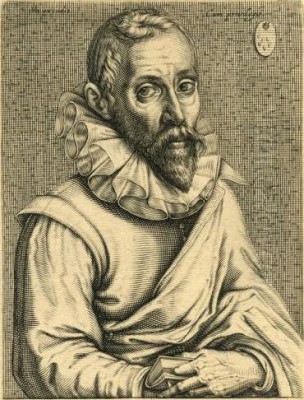
Gillis van Coninxloo III stands as a pivotal figure in the history of Flemish and Dutch landscape painting, a master whose work bridged the late Renaissance and the burgeoning Baroque era. Born into a family of artists in Antwerp and active during a period of profound religious and political upheaval, Coninxloo's innovative approach to depicting the natural world, particularly his immersive forest scenes, left an indelible mark on the generations of artists who followed. His life, marked by displacement and artistic evolution, reflects the dynamic cultural currents of late 16th and early 17th century Europe.
Early Life and Artistic Formation in Antwerp
Gillis van Coninxloo III was born on January 24, 1544, in the bustling artistic and commercial hub of Antwerp. He hailed from a lineage of painters; his father was the painter Jan van Coninxloo II, and his grandfather was also an artist. This familial environment undoubtedly nurtured his early artistic inclinations. Antwerp, at this time, was one of Europe's most prosperous cities and a leading center for the arts, providing a rich training ground for aspiring painters.
Coninxloo's formal artistic education involved apprenticeships under several notable masters. He is recorded as having studied with Pieter Coecke van Aelst the Younger, a versatile artist known for his tapestries, paintings, and architectural designs, who had himself absorbed Italian Renaissance influences. Though Coecke died when Coninxloo was still young, any early exposure would have been significant. Later, he trained under Lenaert Kroes and, more significantly, Gillis Mostaert. Mostaert was a prolific painter of landscapes, genre scenes, and religious subjects, and his workshop would have provided Coninxloo with a comprehensive understanding of contemporary Flemish painting practices.
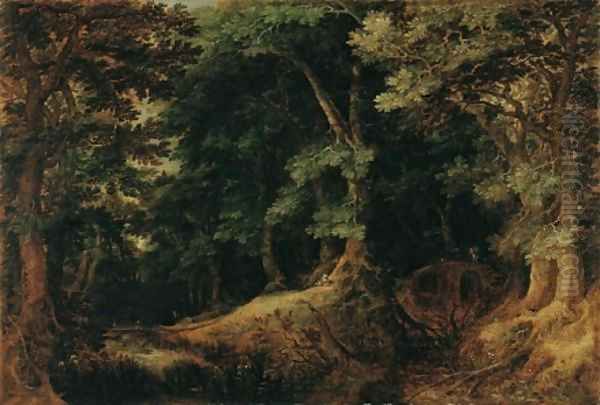
By 1570, Coninxloo had achieved the status of a master, being admitted into the prestigious Antwerp Guild of Saint Luke. Membership in the guild was essential for practicing as an independent artist, allowing him to take on pupils and sell his work. During his Antwerp period, which lasted until 1585, he established himself as a respected painter, likely producing works that reflected the prevailing Mannerist tendencies in landscape, often characterized by fantastical elements and a somewhat artificial arrangement of space, a style also seen in the works of artists like Herri met de Bles or Joachim Patinir, who pioneered the "world landscape" genre.
Religious Persecution and Exile: The Frankenthal Period
The late 16th century was a time of intense religious conflict in the Low Countries. The Protestant Reformation had taken firm root, leading to clashes with the ruling Catholic Habsburg authorities. Antwerp, a city with a significant Protestant population, became a focal point of these tensions. The Spanish Fury in 1576, a brutal sacking of the city by mutinous Spanish troops, and the subsequent fall of Antwerp to Spanish forces under Alexander Farnese, Duke of Parma, in 1585, had profound consequences for its Protestant inhabitants.
As a Calvinist, Gillis van Coninxloo was among the many artists, intellectuals, and craftsmen who chose exile over renouncing their faith or living under repressive rule. In 1585, he left Antwerp, a decision that would significantly redirect his life and artistic career. He initially sought refuge in Zeeland, but by 1587, he had settled in Frankenthal, a town in the Palatinate region of Germany. Frankenthal had become a prominent center for Flemish Protestant émigrés, and an active artistic community flourished there, often referred to as the "Frankenthal School."
During his decade in Frankenthal (circa 1587-1595), Coninxloo's art underwent a significant transformation. It was here that he began to develop his signature style of dense, immersive forest landscapes. Artists like Anton Mirou and Pieter Schoubroeck were also active in Frankenthal, contributing to a vibrant exchange of ideas. Coninxloo's work from this period shows a move away from the panoramic "world landscapes" of earlier generations, such as those by Pieter Bruegel the Elder or Joachim Patinir, towards a more intimate and focused engagement with the forest interior. He began to depict trees not merely as backdrop elements but as the primary subject, creating a sense of enclosure and often imbuing his scenes with a palpable atmosphere.
The Amsterdam Years: Maturity and Widespread Influence
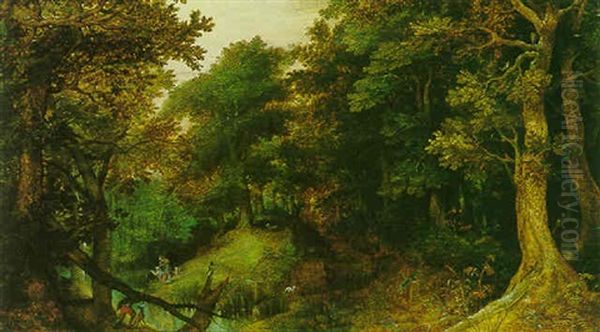
Around 1595, Gillis van Coninxloo made his final move, relocating to Amsterdam. The Dutch Republic, particularly Amsterdam, was rapidly ascending as a major economic and cultural power, offering religious tolerance and abundant opportunities for artists. Coninxloo quickly established himself in this thriving metropolis, obtaining citizenship in 1597. He would spend the remainder of his life in Amsterdam, until his death on January 4, 1607. He was buried in the Zuiderkerk.
In Amsterdam, Coninxloo's innovative forest landscapes found an appreciative audience and exerted a powerful influence on the development of Dutch Golden Age landscape painting. He became a leading figure in the city's artistic circles. His studio was active, and he is known to have taken on pupils, further disseminating his style. Artists like Hercules Segers, Esaias van de Velde, and Willem Buytewech, who were instrumental in shaping early Dutch landscape, would have been aware of Coninxloo's work, even if not direct pupils.
His paintings from this period are characterized by their rich detail, dynamic compositions, and a heightened sense of naturalism, although still often imbued with a certain romantic or idealized quality. He masterfully captured the play of light filtering through dense foliage, the gnarled textures of tree trunks, and the lush undergrowth of the forest floor. These were not just depictions of trees, but evocations of the forest as a living, breathing entity, often with a low viewpoint that drew the viewer directly into the scene.
Artistic Style and Innovations: The Forest as Protagonist
Gillis van Coninxloo's most significant contribution to art history was his revolutionary approach to landscape painting, particularly his development of the forest scene as an independent genre. While earlier artists like Albrecht Altdorfer of the Danube School had painted detailed forest studies, and Flemish predecessors like Pieter Bruegel the Elder had incorporated extensive wooded areas into their compositions, Coninxloo was among the first to make the forest interior the dominant, almost exclusive, subject of his paintings.
His style evolved throughout his career. Early works, influenced by the Antwerp Mannerist tradition and perhaps artists like Paul Brill (who was active in Rome but whose work was known in the North), might have featured more open compositions with distant vistas and somewhat stylized trees. However, particularly from his Frankenthal period onwards, he increasingly focused on close-up, immersive views of dense woodlands.
Key characteristics of Coninxloo's mature style include:
Dense Compositions: His forests are often thick and impenetrable, with little or no sky visible. Trees fill the canvas, their branches intertwining to create a rich tapestry of foliage.

Low Viewpoint: This technique draws the viewer into the scene, creating a sense of being enveloped by the forest.
Emphasis on Texture and Detail: Coninxloo paid meticulous attention to the rendering of bark, leaves, and undergrowth, giving his scenes a tactile quality.
Dynamic Light and Shadow: He skillfully used chiaroscuro to create depth and drama, with sunlight often filtering through the canopy to illuminate specific areas.
Rich Color Palette: His paintings are typically characterized by deep greens, browns, and ochres, creating a lush and earthy atmosphere.
Integration of Figures: While the landscape was paramount, Coninxloo often included small figures – hunters, travelers, or mythological/biblical characters – which added narrative interest and scale, but rarely dominated the scene. These figures were sometimes painted by other artists, a common practice at the time.
Coninxloo's approach marked a departure from the more panoramic and often allegorical landscapes of the earlier 16th century. He brought a new level of intimacy and naturalism to landscape painting, paving the way for the more overtly realistic Dutch landscapes of the 17th century. His work represents a crucial transition from the Mannerist world landscape to the more specialized and naturalistic landscapes of the Baroque era.
Representative Masterpieces
While many of Coninxloo's works are not precisely dated, several key paintings exemplify his style and influence.
_Forest Landscape_ (1598)
Currently housed in the Liechtenstein Collection, Vaduz, this painting is a quintessential example of Coninxloo's mature style. It depicts a dense, lush forest interior, with towering trees whose foliage creates a thick canopy, allowing only dappled light to penetrate to the forest floor. The composition is dynamic, with a winding path leading the viewer's eye into the depths of the woods. Small figures of hunters and their dogs are almost swallowed by the overwhelming presence of nature. The meticulous rendering of leaves, bark, and undergrowth showcases Coninxloo's keen observation and technical skill. This work perfectly illustrates his ability to create an immersive and atmospheric woodland scene.
_The Judgment of Midas_ (1588)
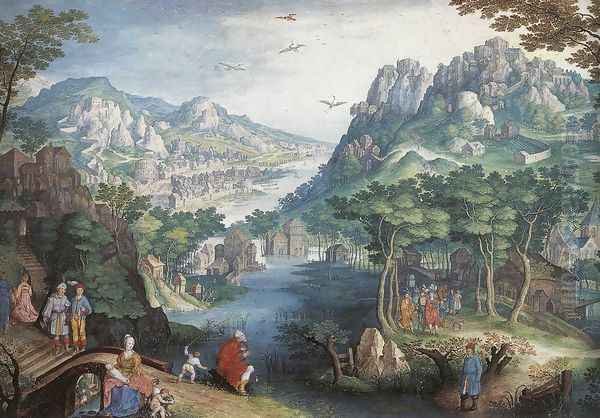
Located in the Staatliche Kunstsammlungen Dresden, this earlier work, likely painted during his Frankenthal period, combines a mythological narrative with an expansive forest landscape. The story, taken from Ovid's Metamorphoses, depicts the musical contest between Apollo and Pan, with King Midas unwisely judging Pan the victor. While the figures are prominent, the surrounding landscape is richly detailed and demonstrates Coninxloo's growing interest in complex forest scenery. Some scholars suggest that the figures might have been painted by another artist, possibly Karel van Mander, who was a contemporary and also a chronicler of Netherlandish artists in his Schilder-boeck. The landscape itself, with its varied trees and sense of depth, is characteristic of Coninxloo's evolving style.
Other notable works include various "Elijah Fed by the Ravens" scenes and numerous untitled forest landscapes, many of which are found in major museums worldwide, including the Kunsthistorisches Museum in Vienna and the National Gallery in Prague. These paintings consistently demonstrate his preoccupation with the intricate beauty and wildness of the forest.
Teachers, Influences, and Contemporaries
Coninxloo's artistic development was shaped by his teachers and the broader artistic environment of his time.
His primary teachers were Pieter Coecke van Aelst the Younger, Lenaert Kroes, and Gillis Mostaert. Mostaert, in particular, as a painter of diverse subjects including landscapes, likely had a significant impact on Coninxloo's early landscape conceptions.
He was also undoubtedly influenced by the established tradition of Flemish landscape painting. The pioneering "world landscapes" of Joachim Patinir and the more naturalistic yet still panoramic views of Pieter Bruegel the Elder formed the backdrop against which Coninxloo's innovations emerged. While Bruegel's landscapes were often settings for peasant life or biblical narratives, his detailed observation of nature and atmospheric effects were influential. The work of Herri met de Bles also contributed to this tradition.
The Italianate landscapes of artists like Paul Brill, who was a Fleming active in Rome, also found their way north through prints and paintings. Brill's more fantastical and sometimes dramatic mountain and forest scenes may have resonated with Coninxloo, especially in his earlier works.
Among his contemporaries, Karel van Mander was not only a painter but also an important art theorist and biographer. His Schilder-boeck (Book of Painters) from 1604 provides valuable information about Coninxloo, praising him as an excellent landscape painter. Other landscape painters active during Coninxloo's time included Jacob Grimmer and Hans Bol, who also contributed to the evolution of the genre in Flanders. His own brothers, Hans van Coninxloo III and Gillis van Coninxloo II, were also painters, though less renowned. The architect and designer Cornelis Floris de Vriendt was a dominant figure in Antwerp's artistic scene during Coninxloo's formative years, shaping the broader visual culture.
Pupils and Lasting Legacy
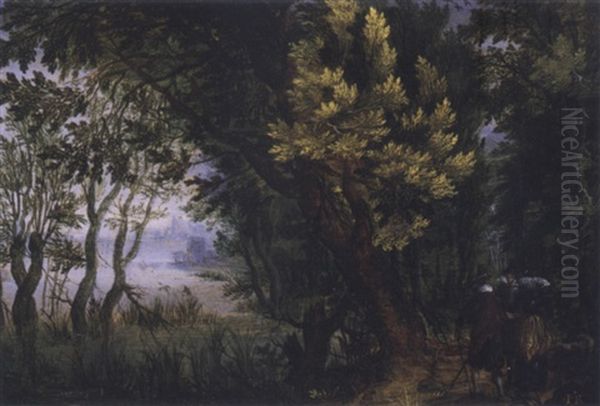
Gillis van Coninxloo's impact on subsequent generations of landscape painters was profound, particularly in the Dutch Republic. His innovative approach to forest scenery was adopted and further developed by a host of artists.
Karel van Mander mentions several pupils, though identifying their specific works can be challenging. Among those most clearly influenced by him were:
Roelandt Savery: Though Savery developed his own distinctive style, characterized by exotic animals and meticulously detailed foliage, his dense forest compositions and close attention to natural detail owe a significant debt to Coninxloo. Savery, like Coninxloo, also spent time in Amsterdam and later worked for Emperor Rudolf II in Prague.
David Vinckboons: Also a Flemish émigré to Amsterdam, Vinckboons was a versatile artist who painted genre scenes, elegant companies, and landscapes. His forest scenes often show the clear influence of Coninxloo's dense compositions and lighting, though Vinckboons frequently populated his landscapes with more prominent figural groups, sometimes in a Bruegelian vein. He was also Coninxloo's son-in-law, marrying his daughter Annetje (Anna) Coninxloo.
Hercules Segers: A highly original and experimental artist, Segers' dramatic and often melancholic mountain and forest landscapes, while unique, show an affinity with Coninxloo's immersive approach and his ability to evoke powerful moods through landscape.
Abraham Govaerts: A younger Flemish painter active in Antwerp, Govaerts specialized in forest landscapes that clearly followed the tradition established by Coninxloo and Jan Brueghel the Elder.
Beyond direct tutelage, Coninxloo's paintings, widely admired and collected, served as models for many other artists. He is considered a key figure in the transition towards the specialized landscape painting that became a hallmark of the Dutch Golden Age. Artists like Esaias van de Velde, Jan van Goyen, and Jacob van Ruisdael, while developing their own distinct styles, built upon the foundations laid by pioneers like Coninxloo who had elevated landscape to a primary subject and explored new ways of representing the natural world. His influence can even be traced to artists of the "Frankenthal School" like Pieter Schoubroeck and Anton Mirou.
Anecdotes and Personal Life
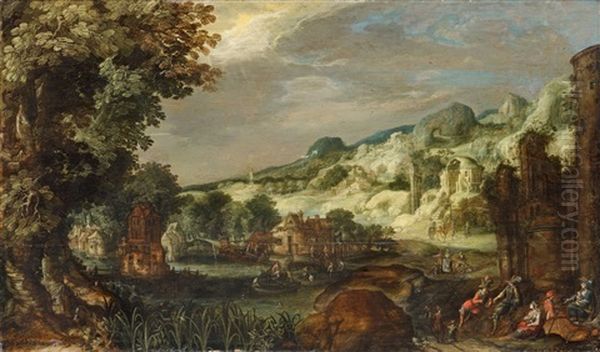
Details about Coninxloo's personal life are somewhat scarce, primarily gleaned from archival records and Karel van Mander's account. His decision to leave Antwerp in 1585 due to religious persecution is a central event, highlighting the profound impact of the Dutch Revolt on the lives of individuals. This exile experience, shared by many artists and craftsmen, led to a significant diaspora of Flemish talent, which in turn enriched the artistic scenes of their new homes, notably in Germany and the Dutch Republic.
Van Mander describes Coninxloo as an "excellent landscape painter of Antwerp" and notes his move to Frankenthal and later to Amsterdam. He praises Coninxloo's particular skill in depicting trees and forests, stating that his way of painting foliage was "very commendable."
Upon his death in Amsterdam in 1607, an inventory of his estate was made, which included a significant number of his own paintings as well as works by other artists. The subsequent sale of his collection likely contributed to the dissemination of his works and further enhanced his posthumous reputation. The fact that he owned property in Amsterdam also attests to his success as an artist in his later years. The details of his house, including its kitchen design and drainage, have even been subject to some historical research, painting a small picture of domestic life at the time.
The controversy or discussion regarding potential collaborations, such as with Karel van Mander on The Judgment of Midas, is typical for the period, where workshop practices often involved multiple hands contributing to a single artwork. However, Coninxloo's primary reputation rests firmly on his mastery of landscape.
Conclusion: A Forester of Art
Gillis van Coninxloo III was more than just a skilled painter; he was an innovator who fundamentally changed the way artists approached landscape. By turning his gaze inward, into the dense, complex world of the forest, he opened up new expressive possibilities for the genre. His life, marked by the religious and political turmoil of his era, saw him transplant his talents from Antwerp to Frankenthal and finally to Amsterdam, enriching each artistic community he joined.
His legacy is evident in the flourishing of landscape painting in the 17th century, particularly in the Dutch Republic. He taught his contemporaries and successors to see the forest not just as a backdrop, but as a subject worthy of profound artistic exploration. Through his immersive compositions, his meticulous attention to natural detail, and his ability to evoke the atmosphere of the deep woods, Gillis van Coninxloo carved out a unique and enduring niche in the history of art, forever remembered as one of the great pioneers of forest landscape painting.